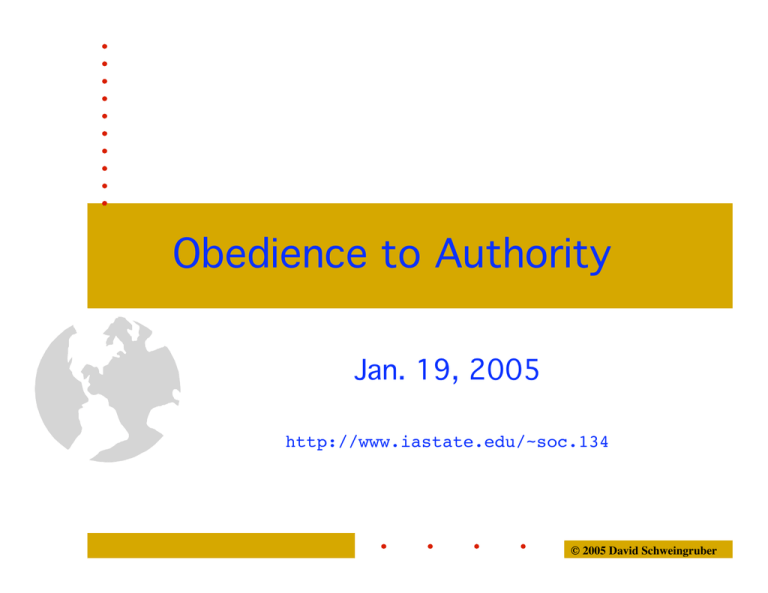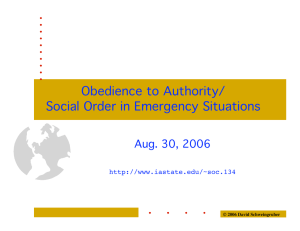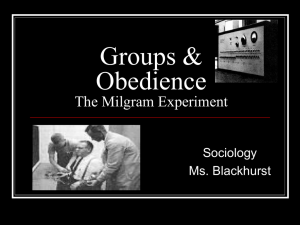Obedience to Authority Jan. 19, 2005 © 2005 David Schweingruber
advertisement

Obedience to Authority Jan. 19, 2005 http://www.iastate.edu/~soc.134 © 2005 David Schweingruber Milgram’s experiment Experiment: research method designed to elicit some sort of behavior, typically conducted under closely controlled laboratory circumstances Disguised as a learning experiment with experimenter playing role of “scientist” and confederate playing role of “learner” Real subject is assigned role of “teacher” in rigged drawing Design: teacher ordered by scientist to deliver shocks to learner after mistakes Source: Milgram, Stanley. 1974. Obedience to Authority. New York: Harper. ©©2005 2000David DavidSchweingruber Schweingruber Measuring obedience Obedience is measured by how intense a shock the teacher is willing to give 31 levels in 15-volt intervals (0-450 volts) Source: Milgram, Stanley. 1974. Obedience to Authority. New York: Harper. ©©2005 2000David DavidSchweingruber Schweingruber Working with a script All grunts, screams and complaints of learner are scripted (or recorded) Three key moments: • 150: “Experimenter, get me out of here! I won’t be in the experiment any more! I refuse to go on!” • 300: Shouts in desperation that he will no longer provide answers • 350: He is not heard from again Scientist has script for replying to teacher’s concerns • E.g., “Although the shocks may be painful, there is no permanent tissue damage, so please go on.” Source: Milgram, Stanley. 1974. Obedience to Authority. New York: Harper. ©©2005 2000David DavidSchweingruber Schweingruber Results: Closeness series Voltage designation Remote Voice Same room Touch Slight shock (15-60) 1 Moderate shock (75-120) 8 Strong shock (135-180) Very strong shock (195-240) Intense shock (255-300) Extreme shock (315-360) Danger: severe shock (375-420) XXX (435-450) Mean shock level Percent obedient Source: Milgram, Stanley. 1974. Obedience to Authority. New York: Harper. 5 8 1 26 27.0 65.0% 2 5 25 24.5 62.5% 12 1 6 3 1 16 20.8 40.0% 20 2 3 3 12 17.9 30.0% ©©2005 2000David DavidSchweingruber Schweingruber The peer series Source: Milgram, Stanley. 1974. Obedience to Authority. New York: Harper. ©©2005 2000David DavidSchweingruber Schweingruber Results: Peer series Voltage designation Two peers rebel Peer gives shock Slight shock (15-60) Moderate shock (75-120) 1 Strong shock (135-180) 8 Very strong shock (195-240) 16 2 1 Intense shock (255-300) 6 4 1 4 16.5 10.0% 37 28.7 92.5% Extreme shock (315-360) Danger: severe shock (375-420) XXX (435-450) Mean shock level Percent obedient Source: Milgram, Stanley. 1974. Obedience to Authority. New York: Harper. ©©2005 2000David DavidSchweingruber Schweingruber Professor of Old Testament (150 volts) E: It’s absolutely essential to the experiment that we continue. S: I understand that statement, but I don’t understand why the experiment is placed above this person’s life. E. There is no permanent tissue damage. S: Well, that’s your opinion. If he doesn’t want to continue, I’m taking orders from him. E: You have no other choice, sir, you must go on. S: If this were Russia maybe, but not in America. E: (During debriefing) What in your opinion is the most effective way of strengthening resistance to inhumane authority? S: If one had as one’s ultimate authority God, then it trivializes human authority. Source: Milgram, Stanley. 1974. Obedience to Authority. New York: Harper. ©©2005 2000David DavidSchweingruber Schweingruber Industrial engineer (255 volts) S: No, I can’t continue. I’m sorry. E: The experiment requires that you go on. S: The man, he seems to be getting hurt. E: There is no permanent tissue damage. S: Yes, but I know what shocks do to you. I’m an electrical engineer, and I have had shocks… and you get real shook up by them—especially if you know the next one is coming. I’m sorry. Source: Milgram, Stanley. 1974. Obedience to Authority. New York: Harper. ©©2005 2000David DavidSchweingruber Schweingruber Social worker (450 volts) During the debriefing, the subject stated that he considered “not going through with it,” but he didn’t mean that he considered disobeying but rather that he considered modifying the manner of teaching the victim. S: At one point I had an impulse to just refuse to continue with this kind of teaching situation. E: At what point was this? S: This was when I asked you a question as to whether I have a choice in my teaching method. At this point my impulse was to plead with him, talk with him, encourage him, try to ally myself with his feelings, work at this so we could get this through together and I wouldn’t have to hurt him. Source: Milgram, Stanley. 1974. Obedience to Authority. New York: Harper. ©©2005 2000David DavidSchweingruber Schweingruber Nurse (450 volts) During the debriefing, the subject points out that in a hospital nurses have a right to question a doctor’s orders if they appear to be harmful to the patient. S: "If I question the dose of a drug, I can ask the doctor three times: ‘Is this the order you want? Is this the order you want?’ And, if he keeps on saying ‘Go ahead,’ and I know this is too much, I may call his attention to the fact that it’s too much. It’s not that you are better than he is, but you can say, ‘Did you want her to have so much, doctor,’ and then you repeat it. Then you have the right to bring the question up to the supervisor." In the experiment she "questioned" the voltage levels but was fully satisfied with the answers provided by the experimenter. Source: Milgram, Stanley. 1974. Obedience to Authority. New York: Harper. ©©2005 2000David DavidSchweingruber Schweingruber Water inspector (450 volts) S: "This is all based on a man’s principle in life, and how he was brought up and what goals he sets in life. How he wants to carry on things. I know that when I was in the service, [If I was told] ‘You go over the hill, and we’re going to attack,’ we attack. If the lieutenant says, ‘We’re going to go on the firing range, you’re going to crawl on your gut,’ you’re going to crawl on you gut. And if you come across a snake, which I’ve seen fellows come across, copperheads, and guys were told not to get up, and they got up. And they got killed. So I think it’s all based on the way a man was brought up in his background." S: "Well, I faithfully believed the man was dead until we opened the door. When I saw him, I said, ‘Great, this is great.’ But it didn’t bother me even to find that he was dead. I did a job." Source: Milgram, Stanley. 1974. Obedience to Authority. New York: Harper. ©©2005 2000David DavidSchweingruber Schweingruber Some key points from Milgram Experiment illustrated social influence—the effect of other people on our thoughts, perceptions and behaviors The most effective way of limiting obedience was to have the subject’s peers rebel People underestimated the effect of social influence when explaining their own behavior Interviews with some subjects revealed the importance of socialization and ideology ©©2005 2000David DavidSchweingruber Schweingruber




![milgram[1].](http://s2.studylib.net/store/data/005452941_1-ff2d7fd220b66c9ac44050e2aa493bc7-300x300.png)



